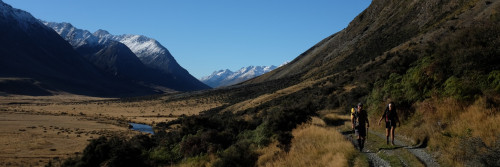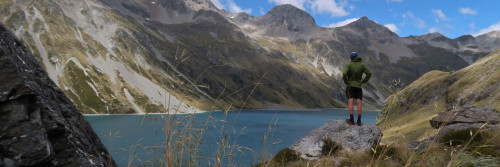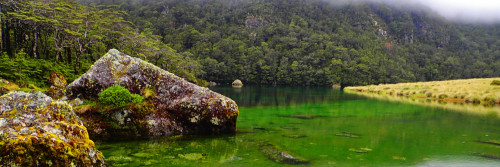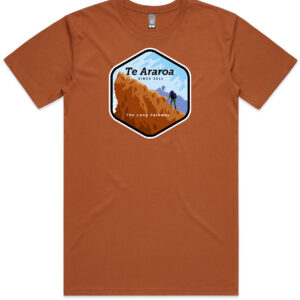News and media
The shining stile
(Reprinted from the Sunday Star Times 10/12/00)
"The Shining Stile" Report by Geoff Chapple
Cows come and rub their necks on it.
The pukekos, the herons, the magpies come and sit on it. When I returned to it this week, a month after the construction team had been through, I saw the birds had bombed the thing - white rimed, black centred guano, dripping and setting at the same time - avian Salvador Dali clocks. God knows what those birds eat.
But the stile stands there, sturdy, a little surreal, suggestive of something more abstract, more vast, more obscure, more important.
Recently I was guest speaker to the Waikato Tramping Club. "Waiting for the New Zealand-long foot trail," I regaled the meeting, "is like waiting for the other shoe to drop. You know it's coming, indeed a few of you may remember that first thump 25 years ago when the New Zealand Walkway Commission began the job. But between then and now . . . . silence. However - "
Pausing for dramatic emphasis I pressed the button on the slide projector, and on-screen flashed a picture of the stile. Te Araroa Trust, I explained, had taken up the task of putting that trail in, Cape Reinga to Bluff - and by degrees it was doing it. This stile was part of a soon-to-be-opened trail that ran from Meremere to Rangiriri on the Waikato River stopbanks. This stile -
A puzzled query came out of the darkened church hall.
"That's a great stile Geoff but - I can't see any fence."
No fence! And you may suddenly suspect that Te Araroa Trust is an outfit so dedicated to the task that its work gangs descend out of the blue, and bang in a stile for the sake of it, much as the fabled patupaiarehe once built their whimsical reef-rock crossing of the Waitemata Harbour.
But wait up. Earlier this year, with damage from the 1998 flood still a raw memory, a bulldozer came in to raise the stopbanks 300 mm. To give the machine access, the farmers took their electric fences down. Then we came along. We'd negotiated a walkway licence from Environment Waikato to put a trail down the stopbank. We had support from the Labour Department's Community Employment Group, and we'd won a Lottery Grants Board Millennium SubCommittee grant to put it in. A skilful team from Horahora Marae and Huntly West - Sonny Hapi, Jeff Kani, Bill McLeman and Ricki Curran - was poised to go, but the first stretch had no fences. Farmer Mike Peters solved it, driving me down the stopbank gesturing left and right, and I sprayed Dazzle where the new fences would go. On that Dazzle we built our first stiles.
The stopbank: green selvage to the sometimes unruly river. I first walked it two years back as part of a pilgrimage down the North Island to establish a trail route. It was as obstructed then as Flanders Field. I rolled under electric fences, snagged my fatigues on barbed wire strands, waded across boggy ground, and advanced finally on a bull, holding out as my fixed bayonet, a Leki hiking stick.
But these were mere aggravations. By degrees on that walk, a cleaner spirit prevailed. It's very quiet down by the Waikato. The river exudes a slight but distinctive chill. Huge goldfish - koi carp - raise fat and wordless lips from the shallows as you go by, and that, in mimicry, is the Waikato's great and secret charm - the utter silence as its mighty tonnages of fresh water slip by. In spring this year we broke the silence. Our Suzuki quad towed along the Waikato River stopbank a jouncing trailer. The coils of wire, the strainer posts the cut lengths of timber, the boxes of galvanised nails, the posthole borer, the chainsaw, the Estwing hammers, shovels, rammers and the great old-fashioned carnival-style maul all hung momentarily and successively weightless after each jounce, before making a cacophonous touchdown.
We built the stiles. We dug high-revving holes. Our posthole borer didn't have a clutch, and when you hit something underground - an old concrete post perhaps or some iron implement from the unrecorded layers of Waikato farm history - it'd swing you around on your outstretched arms arms like Daddy used to at the beach. We'd heave four strainer posts into those 80 cm holes and ram the earth, for unless they were buried that deep, that tight, the cattle would rub them sideways. We'd chainsaw the posts across at two levels - 400 mm above the ground for the first opposing pair, either side of the fence, 750 mm for the second pair. Using spirit levels for accuracy we'd nail onto that sturdy foundation two metre-long pieces of 6 x 2 set in an X-shape, one above the other, the stile treads. We'd drill them through, and bind them down onto the posts below with number 8 wire. Then we'd staple anti-skid GeoGrid onto the treads. To complete the stile, we'd take the maul, and drive a long piece of 4 x 2 into the ground, staple it to the fencewire, and shape the top into a handhold. To steady your stile crossing.
Cold spring winds blew upriver, and up your shirt, and one carpenter we'd brought up from the South Island went down with pneumonia. Another man dropped with bronchitis. One of our workers bounced a chainsaw off his boot, cutting a neat notch in the leather.
OSH requires every construction team to have a safety officer on site whose job it is to warn of all workplace hazards. I was that safety officer. It became something of a joke, for all the guys on our team knew more about chainsaws, electric fences, rivers, posthole borers than I did - but I did it nonetheless.
Beware kickback from the chainsaw, I intoned. Beware the river, and if you do fall in go with the current, come ashore downstream, don't fight to get back to where you fell in. Beware the electric fences. Their shock is like a blow to the shoulders with a cricket bat. Their 3000 volts will turn you as incandescent as a lightbulb filament. Check if they're live by laying a blade. of grass on the wire and gradually sliding your fingers up, thus - ouch! People joke about electric fences, I said, but there have been bulls, their necks tangled in the pulsating wire and unable to escape, killed by electric fences. But I wasn't on-site when a frantic mobile call came through -
"Kani's broken his ankle."
"What happened?"
"He was jumping one of the fences and came down the other side. I think his foot slipped on a cowpat."
Damn - Safety Officer hadn't warned about the hazards of cowshit.
But there it is. An 18 kilometre trail, the fences now stiled, and the worst bit of swamp boardwalked. The support for a Te Araroa opening has been generous. New Lynn company Trethewey Granite and Marble donated the one-tonne boulder of Waikato ignimbrite, classic pyroclastic rock. Sculptor Steve Woodward is sandblasting a text onto that, gratis, as I write. We always try for local poetry on our trail-start stones, and were a little stumped as to who exactly the Waikato school of poets might be until - of course - we thought of Jools and Lynda Topp, raised just west of Huntly. The yodelling school, and the talented twins volunteered three lines from their 1997 song - Turangawaewae.
"A sacred place to be By the banks of the mighty Waikato As she flows out to the sea."
Tainui kaumatua Tahi Ngakete and Pat Kingi will do the karakia. Then Sir Edmund Hillary will unveil the stone and open the trail and those of the guests who wish to, can walk it. They'll get a surprise perhaps. The trust doesn't lay down a path in the strict sense, our budgets are too small for that. Legal access is our thing, and smoothing the worst impediments. The actual path though will be made by human feet treading the route, much like the trails trodden out by animals. Man and beast tend, by ancient instinct, to get it right.
But stiles we do do. Stiles that are also abstract did someone say? Stiles that transcend themselves? That are in some way more vast, more obscure? "I'm sorry all this took so long Terry," I murmured down the phone a couple of weeks back to Environment Waikato's Property Services Manager, Terry McDonald, one of the behind-the-scenes stalwarts in getting done the many things that need doing for an 18 kilometre trail to go from a mere gleam in Te Araroa's eye to the shining path of reality.
"Well," said Terry. "Rome wasn't built in a day."
"That's right Terry, the right to roam wasn't built in a day."



